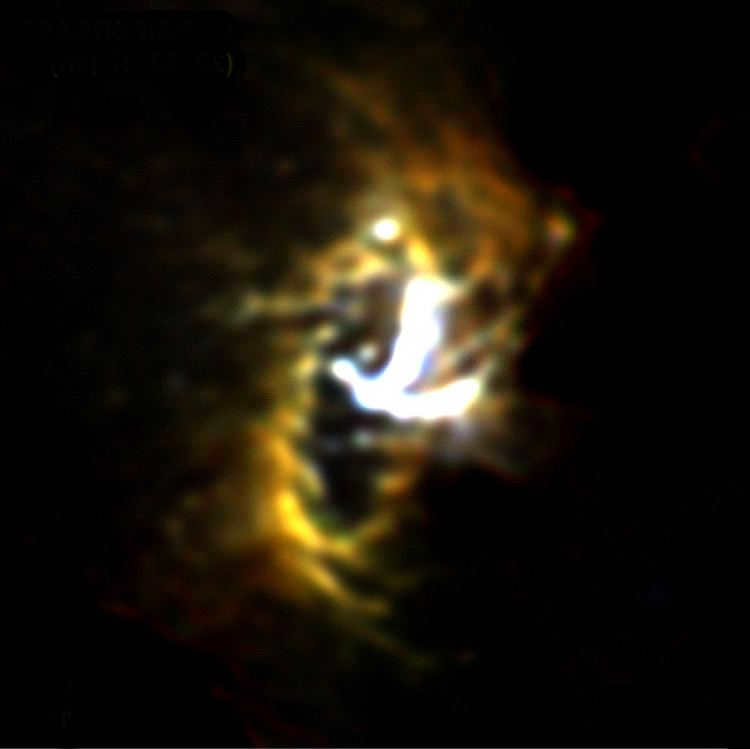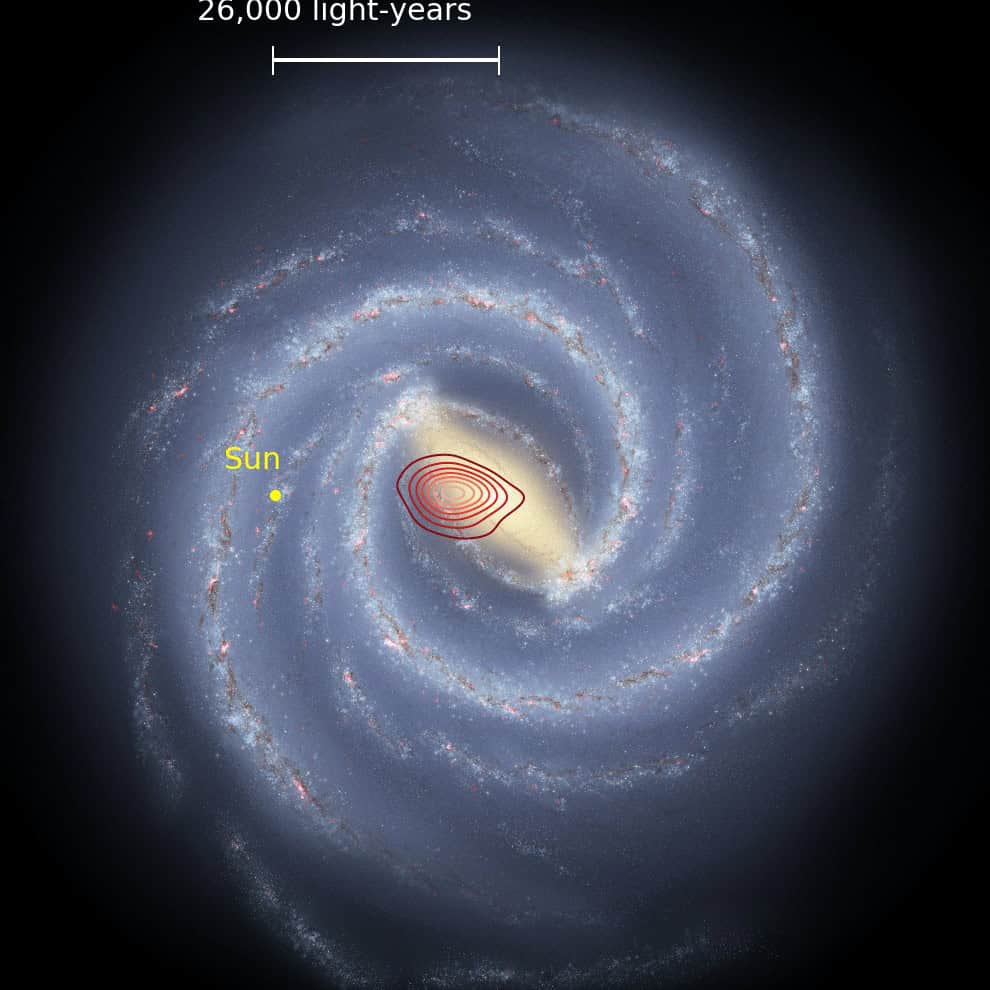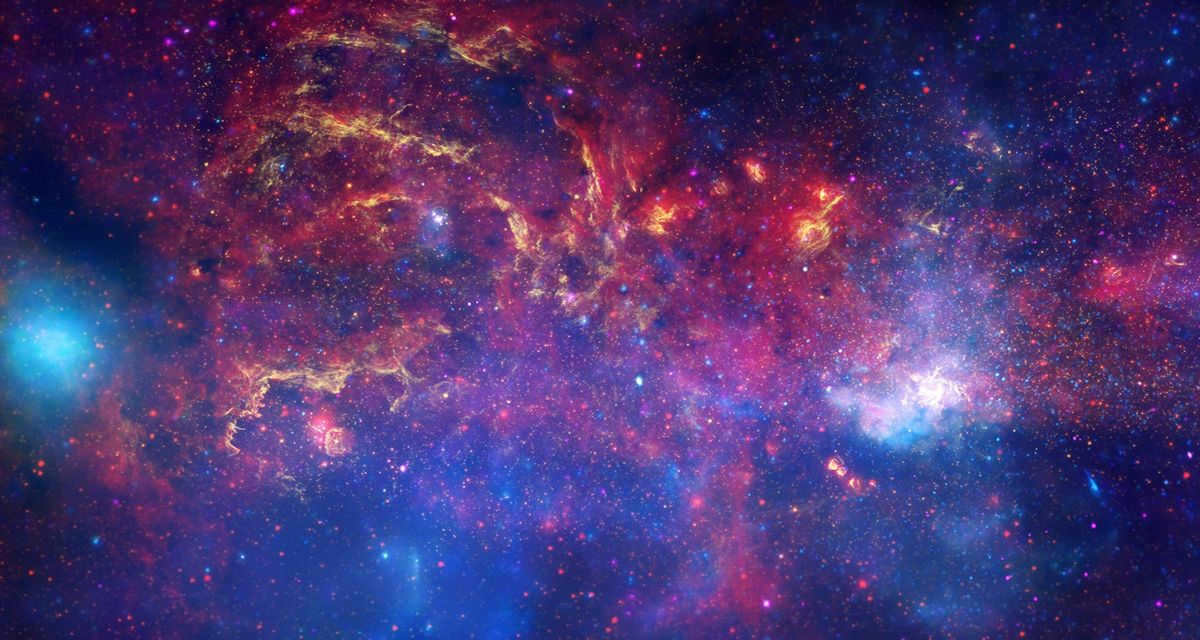
The age of the Milky Way is estimated to be around 13 billion years. Some of the oldest stars in our galaxy were formed shortly after the birth of the Universe. Despite the vast amount of time that has passed, our civilization is the only one known to have reached a technologically advanced stage.
Considering the immense age of our galaxy and its proven potential for supporting life, it is puzzling why we have not detected any signs of other intelligent civilizations. If a civilization emerged in the Milky Way even just 0.1% earlier than ours, they would be millions of years ahead of us in terms of technological development. One would expect that by now, the galaxy would be filled with extraterrestrial spaceships and colonies, especially as we ourselves are on the verge of interplanetary colonization.
Maybe. However, it’s possible that our focus is in the wrong direction. Recent computer simulations conducted by Jason Wright and his team propose that the most promising location to search for civilizations capable of space travel is actually at the core of the galaxy. This particular area has not received much attention from projects dedicated to the search for alien life.
Here, you can see an animated simulation depicting the repopulation of a galaxy. The white dots represent uninhabited stars, while the purple dots represent stars that have been inhabited. The white cubes symbolize ships in transit. The spiral pattern of colonization is a result of the movement of stars within the galaxy. Once the center of the galaxy is reached, the rate of colonization increases dramatically.
Shuffling
Previous mathematical models attempted to estimate the timeframe required for a civilization to expand across the Milky Way. However, due to the immense size of the Galaxy, a complete settlement would take longer than anticipated. What sets the new simulation apart is its consideration of the movement of stars within the Galaxy. Contrary to earlier models, the Milky Way is not stationary; rather, it is a dynamic and ever-shifting cluster of stars. As a result, colonial aircraft and probes must navigate through the moving stars in order to travel between them. This new simulation reveals that stellar motion actually facilitates the colonization of the Galaxy by introducing a dispersal effect into the process of civilization expansion.
The simulation is based on a previous study conducted by Jonathan Carroll-Nellenbeck and his colleagues, which proposed that a hypothetical civilization could expand across a dynamic Galaxy at speeds slower than the speed of light. In this simulation, the civilization’s spacecrafts are assumed to travel at speeds similar to our own aircrafts, which is approximately 30 km/s. When a spacecraft reaches a populated planet in the simulation, it establishes a colony, and if there is an unpopulated planet nearby, it can send out new spacecrafts every 100,000 years. In this simulation, the maximum distance a spacecraft can travel is 10 light years, and the journey itself takes 300,000 years. The virtual colony technology needs to exist for 100 million years before it becomes extinct, but it also has the potential to gain new settlers if another colony becomes reachable.
The outcome is rather distinct. The movement of stars within the Galaxy generates a “leading edge” of the colonization surge. As it reaches the galactic nucleus, the concentration of stars in that region significantly augments the rate of colonization. Even with cautious constraints on spaceship velocities, the majority of the Galaxy can be inhabited in under a billion years.
In the direct field of vision
The findings from the simulation provide backing to a previous proposal made by Vishal Gajjar and his colleagues, who suggested that indications of life should be sought after in the heart of the Milky Way. This particular region not only has the potential for rapid colonization, but it can also be efficiently scanned for advanced technology. The center of the galaxy is directly within our line of sight, making it the most densely populated area with stars. Additionally, due to the formation of the Milky Way from the inside out, the oldest planets are located in the central region, implying that they have had more time to foster the development of life.
Furthermore, the hub acts as a built-in hub for the interchange and dissemination of data. Additionally, if one requires locating a signal, it would be more advantageous to search in proximity to the hub. Gajjar and his associates also proposed the idea that a highly developed civilization might harness energy from the central supermassive black hole of the Milky Way in order to fuel a beacon that spans across the entire galaxy.

A perspective looking towards the heart of the galaxy from the Mojave Desert
Why is the universe so hushed?
All of these factors fail to address our inquiry – where is everyone? The potential pace of galactic colonization presents a challenge in finding an answer. Additionally, Carroll-Nellenbeck and colleagues propose that during the process of colonization, an advanced civilization may invent novel propulsion technologies that shorten settlement time. Furthermore, an initial survey of the galactic core in the radio spectrum yielded no signals. Perhaps the answer lies within the tranquility itself. The galaxy is so ancient that life has had ample time to propagate throughout, leading some to believe that this silence dooms any hopes of encountering extraterrestrial intelligence.
However, there is still a glimmer of hope! According to the simulation, it is conceivable that certain regions of the Galaxy might remain unpopulated even after a substantial amount of time has passed. The key factor to consider here is efficiency. It’s important to bear in mind that colonization follows the path of least resistance. As time goes on, some colonies may perish and become lost, potentially due to cataclysms or the depletion of resources. Instead of venturing further into the depths of space, civilizations opt to repopulate these extinct colonies because they are closer in proximity. As a result, clusters of inhabited colonies emerge, surrounded by uninhabited planets that never witness the presence of sentient beings. Eventually, a static equilibrium is achieved, wherein certain regions of the Milky Way simply do not warrant the effort and resources required for colonization.
There exist alternative explanations for the absence of communication. It is plausible that advanced societies are evolving at a more gradual pace than our assumptions suggest. It is also possible that the numerous civilizations inhabiting the Milky Way are deliberately avoiding contact with one another. Another conceivable reason for the lack of interaction could be that civilizations refrain from interfering with the progress of planets resembling ours, or they may be apprehensive about biological incompatibility on other celestial bodies. These potential factors could elucidate the reason behind our yet unrealized encounter with extraterrestrial life forms – that is, if it indeed has not occurred.
Buried History
Carroll-Nellenbeck and his team have explored the idea of a “temporal limit” – a specific moment in the past beyond which any remnants of past civilizations on Earth would no longer exist. Let’s imagine that a highly advanced extraterrestrial society arrived on our planet billions of years ago, inhabited it for a few thousand years, and eventually perished. Over the course of time, all traces of their presence would have disappeared completely. Therefore, it is entirely plausible that while we haven’t directly encountered aliens, Earth may have indeed been visited by them in the past.
According to the simulation and our position in the galaxy, there is an 89% probability that there is a span of one million years between visits from alien spacecraft – a sufficient amount of time to eliminate any evidence of past colonizations. The simulation suggests that there are intermediate scenarios between a completely empty and a fully occupied Galaxy, which could explain the lack of communication while still leaving open the possibility of an advanced extraterrestrial civilization.
Is there life in globular clusters?
While the central region of the Galaxy appears to be an attractive target for future SETI (Search for Extraterrestrial Intelligence) studies, there are other areas with similar favorable conditions – globular clusters.
Globular clusters are ancient groups of stars that orbit the center of the Galaxy, located tens of thousands of light-years away. These clusters are remnants from a period of active star formation, which was driven by galaxy mergers. In total, there are approximately 150 globular clusters in the Milky Way that are estimated to be 10-13 billion years old.
Three-dimensional model illustrating the known globular clusters and their positions within the Milky Way
Globular clusters have an incredibly high density, with stars packed much closer together than in the typical Milky Way disk. When discussing interstellar travel or the transmission of signals, we often speak in terms of millennia. However, a civilization that has evolved within a globular cluster would only require a few years to travel between stars and a matter of months, or even weeks, to send signals. The challenge, though, lies in the fact that the high concentration of stars in these clusters can have a negative impact on the formation and stability of planets and their orbits.
R. Di Stefano and A. Ray have conducted a calculation to determine the “habitability zone of the SZ.” The habitability zone is typically defined as the range of a planet’s orbit where liquid water can exist on its surface. Fortunately for us, Earth falls within the Sun’s habitable zone. However, in the case of the SZ, the habitable zone is not simply a two-dimensional circle. Instead, it takes the form of a three-dimensional shell that is centered at the cluster’s center. The interior of this shell begins where the density of the SZ decreases to a level that allows for stable stellar systems, considering the gravitational interactions between nearby stars. It is important to note that the gravity of a neighboring star can disrupt the formation of planetary dust disks, which are essential for planet formation. Additionally, a star passing close to another star has the potential to disturb the orbital path of a planet, causing it to be knocked out of its original orbit.
The outermost region of the envelope starts where the density of stars decreases to such an extent that the average distance between them exceeds 10,000 a.u., which is approximately equivalent to two light months. Beyond this point, the benefits of being within a cluster, such as short travel distances and rapid communication, diminish. The space between the two boundaries of the shell presents an optimal opportunity for colonization – stars are sufficiently close for expedient transportation and messaging, yet not so close as to disrupt each other’s systems.
We require this perfect collection to encompass low-mass stars that have longer lifespans compared to others. By a fortuitous coincidence, low-mass stars also possess the smallest radius of habitable zones. Additionally, the proximity of a planet to its parent star decreases the likelihood of it being displaced from its orbit by another star. The SW also displays a phenomenon known as “mass segregation,” where the most massive stars, which have the least favorable systems for habitable zones, are drawn towards the center. As a result, segregation organically arranges stars in order of suitability, from least suitable to most suitable, in the direction from the center towards the periphery.
It appears that in an imaginary SW with a mass of 100,000 times that of our sun, approximately 40% of yellow dwarf stars (similar to our Sun) and 15% of orange and red dwarf stars are located in suitable conditions for potential colonization. This represents a significant number of stars. Additionally, there is a chance that planets expelled from these star systems could support life, benefiting from the combined energy of all the stars in the cluster. This is particularly true if an advanced civilization possessed the technology to harness this energy. Just imagine – a foreign planet freely navigating through space.
According to Di Stefano and Ray, if only 10% of the stars in the Milky Way had planets capable of supporting life, and if only 1% of those planets were suitable for intelligent life, and if only 1% of those intelligent civilizations were capable of transmitting signals, then it would still mean that there must be at least one civilization in every part of the Milky Way. If we consider slightly more positive estimates, it suggests that there could be more civilizations in the less populated areas of the galaxy, but they would still be quite far apart, separated by distances of around 300 light years.
If you resided in the southwestern region, you would have the opportunity to attempt communication with the far-off outer disk of the Milky Way galaxy. Thus far, we have not obtained concrete proof regarding the presence of planets in the northwestern sector. Our current technological capabilities for detecting exoplanets do not enable us to conduct searches at such a vast distance and within the exceptionally dense surroundings of the southeastern quadrant. Nevertheless, should a highly advanced civilization capable of traversing thousands of stars actually exist in the southwestern area, Di Stefano and Ray theorize that it would essentially possess “immortality”.
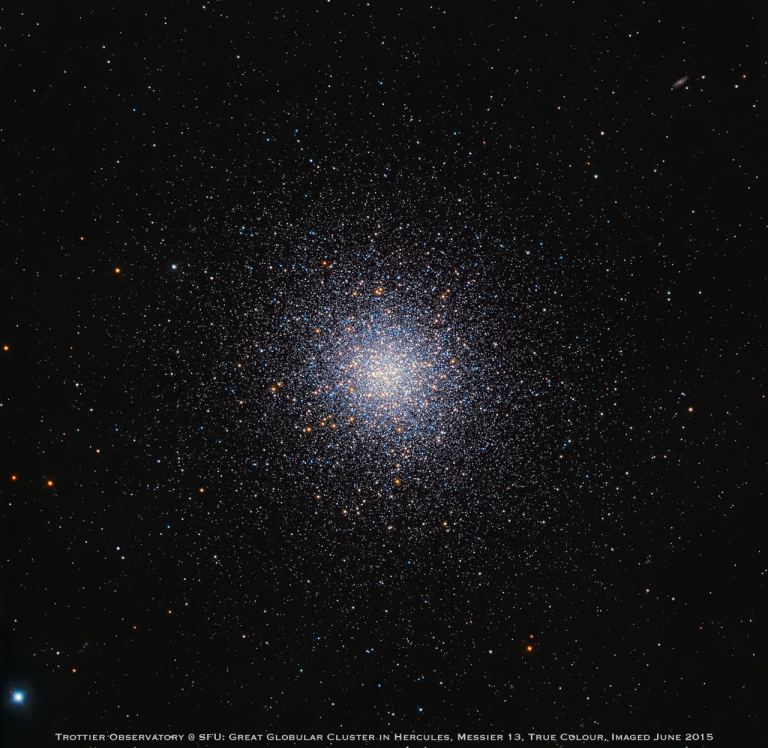
A message was transmitted to a specific SSS, the magnificent star cluster M13 located in the Hercules constellation. Situated 22,000 light-years away, this impressive cluster spans a diameter of 145 light-years and is comprised of approximately 100,000 stars. In 1974, an extensive message was dispatched to M13 from the Arecibo radio telescope. The transmission encompassed a sequence of numbers ranging from one to ten, detailed information about the chemical constituents of DNA, an image depicting a human, a visual representation of the solar system, and an illustration of the telescope itself. The entirety of the message lasted for a duration of three minutes, and it is estimated that it will require several thousand years for it to reach the intended destination within the cluster.
It is highly probable that upon arrival, the message will be indistinguishable. Nevertheless, there remains a possibility that in the future, humanity will encounter a civilization expanding throughout the galaxy, or perhaps even evolve into one ourselves.
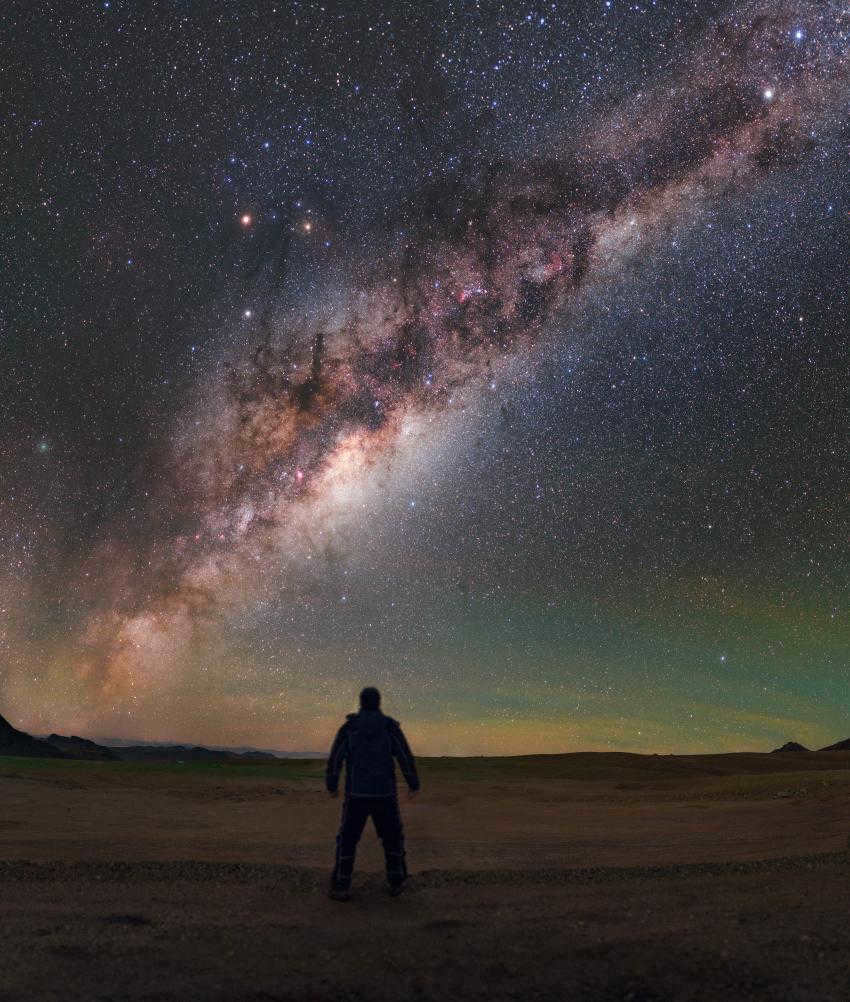
Astronomers are highly fascinated by the central region of our Milky Way galaxy, much like how moths are irresistibly drawn to fire. The core of our galaxy is a hub of numerous intricate processes. Notably, it houses a supermassive black hole, alongside swarms of incredibly ancient red giant stars. The majority of these stars date back to the very beginnings of our Galaxy’s formation.
Using the Canada-France-Hawai’i telescope in Hawaii, astronomers embarked on a study of these stars. Their objective was to gain insights into the stars’ characteristics and lifespan. These observations were conducted as part of the Pristine Inner Galaxy Survey (PIGS) project. Over the course of several years, this project has been dedicated to unraveling the mysteries surrounding the ancient stars within the core of the Milky Way.
PIGS – ancient celestial bodies at the center
Previous research has indicated that the formation of stars took place in the present-day core of the Milky Way. PIGS stars are the remaining original inhabitants of our galaxy, slowly orbiting around its nucleus and spending the majority of their lifespan there. They possess distinct chemical compositions compared to the newer stars dispersed throughout the Milky Way. These older stars consist primarily of hydrogen and helium, implying that they originated during the early stages of cosmic history. In contrast, the younger stars in our galaxy exhibit higher levels of these “metals” [referring to elements heavier than helium], such as carbon, oxygen, nitrogen, and others.
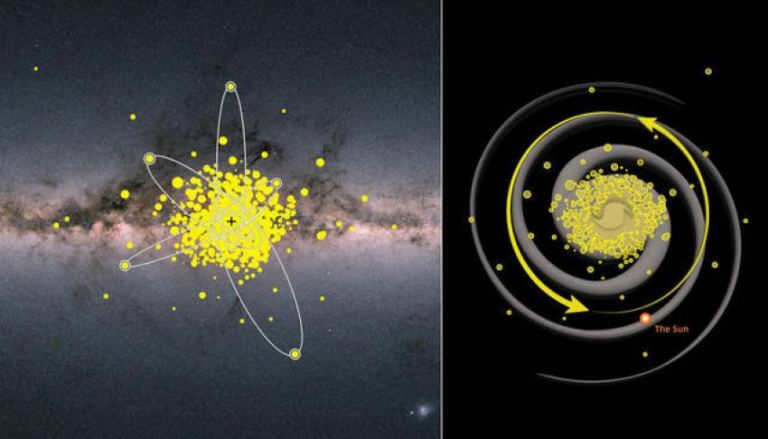
An artistic portrayal of ancient stars located in the central region of the Milky Way. Some examples of star orbits are highlighted on the left side. On the right, their positions in the Galaxy are depicted, with the Sun slowly revolving around it.
In the Universe, numerous stars emerged shortly after the Big Bang from an environment abundant in hydrogen and helium. These stars serve as valuable “samples” for astronomers to investigate the characteristics of stars in our own Milky Way and understand its formative period. Typically, such ancient stars are found in the core of the galaxy and within the cluster of stars forming the Milky Way’s sparse halo.
PIGS team member Anke Arenzen suggests that this research provides evidence that the survey is observing the most ancient stars in the Galaxy. “It is thrilling to consider that we are witnessing stars that originated during the initial phases of the Milky Way’s existence, which were previously nearly impossible to access,” Arenzen remarked. These stars likely came into being within a billion years following the Big Bang and serve as remnants of the early cosmos.
Insights from ancient stars on the origins of the Milky Way
When scientists examine galaxy formation models in order to gain a deeper understanding of the Milky Way’s origins, they observe a consistent pattern of matter aggregating into clusters. This phenomenon occurs repeatedly, from the earliest stages of proto-galaxies to galaxy collisions and even the birth of stars and planets. This phenomenon is commonly referred to as the “hierarchical model” in the field of astronomy.
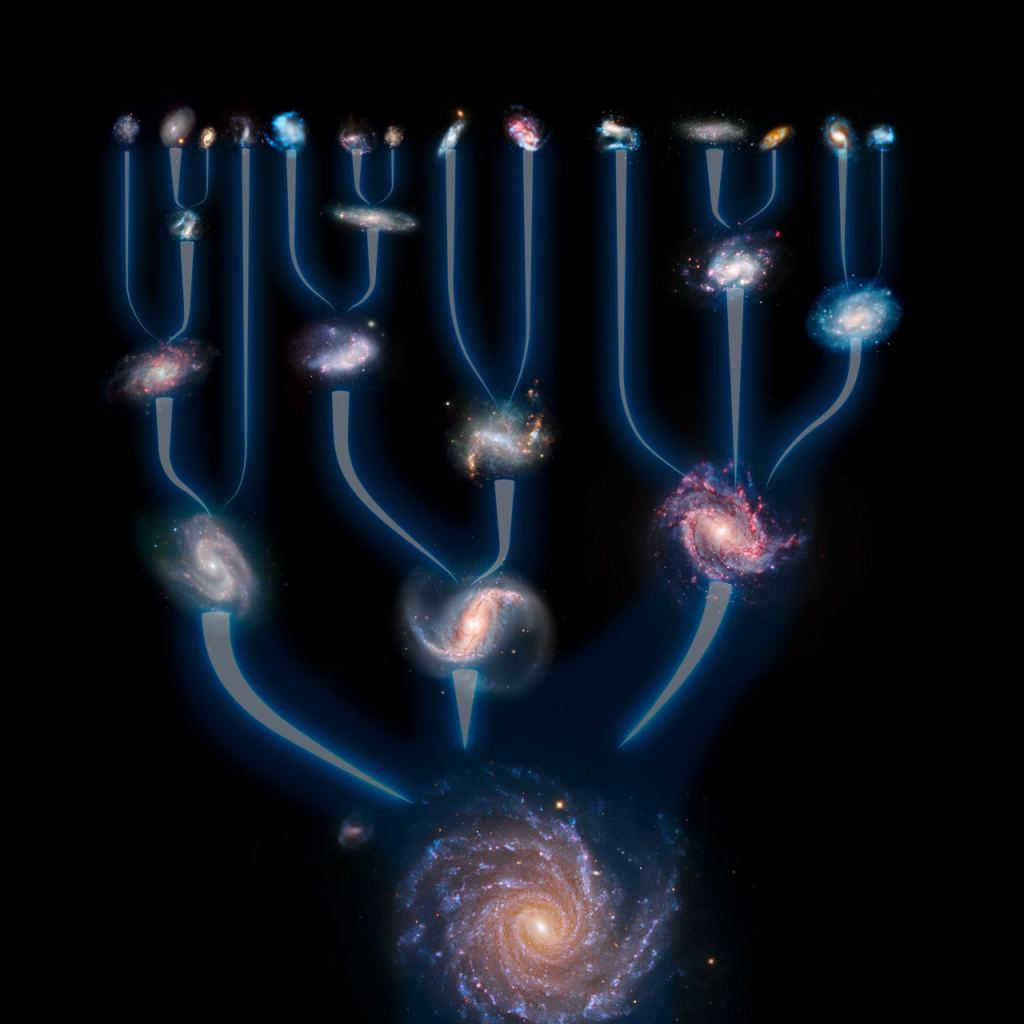
As per the hierarchical model of galaxy formation, the initial stages involve the formation of smaller galactic components that eventually merge together to create bigger galaxies. In this process, stars are formed at an early stage.
There are two primary models for the development of galaxies. One theory suggests that the early Universe consisted of clusters of gas and predominantly dark matter. These clusters gravitationally interacted with each other. Over time, the baryonic matter (non-dark matter) within the clusters cooled and began to contract, forming a protodisk as it rotated. This protodisk eventually fragmented into smaller clusters within the disk, which ultimately became the first stars. In the subsequent stage of the Universe’s evolution, small galaxies collided with one another, merging to form larger galaxies. This, in essence, is known as the top-down formation theory according to astronomers.
According to alternative theories, the process of star formation initiated with the emergence of small gas clouds that transformed into proto-galaxies. Gradually, these protogalaxies combined to give rise to larger galaxies that subsequently began to rotate and form disk-shaped structures. This concept is commonly known as the “bottom-up” theory of formation. In both scenarios, the ultimate galaxies remained encompassed by halos composed of dark matter, which is consistent with our current observations.
Both models propose that the most ancient stars within a galaxy should reside in its densely packed inner regions. This statement holds true for our own galaxy, the Milky Way. By using spectroscopy, astronomers have determined that the chemical properties of these ancient stars correspond to those of the earliest stars to have existed in the Universe.
Are these stars really 12 billion years old?
So, what position does the Milky Way hold in the cosmic order? It started taking shape approximately 13.6 billion years ago, with its initial “core” being a smaller protogalaxy. In comparison, the Universe itself originated from the Big Bang, which is now believed to have happened at least 13.8 billion years ago. Therefore, the earliest stars in the Milky Way are not exactly the same age as the Universe. However, due to their early formation, they provide valuable insights into the conditions during the earliest stages of star formation history.
In order to verify their hypotheses regarding these ancient stars, astronomers require the ability to observe the central region of the Milky Way. However, this task has proven to be quite challenging. The core is obscured by vast clouds of gas and dust, rendering visual observations nearly impossible. Nevertheless, by utilizing specialized filters on telescopes or examining different wavelengths of light, such as infrared or radio waves, astronomers are able to effectively detect these stars. The subsequent objective is to determine their age by analyzing their light for metal content. In comparison to their younger counterparts in other regions of the Galaxy, there are not many older stars. Therefore, astronomers are actively seeking stars with low metal content, as these are more likely to be the older ones.
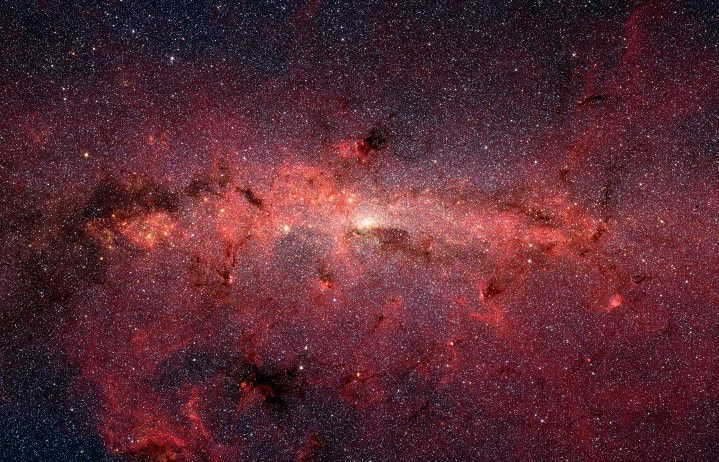
This vibrant infrared picture captures the mesmerizing sight of hundreds of thousands of stars huddled together in the dynamic heart of our spiral Milky Way galaxy
The insights these stars provide about the Milky Way
The observations made by PIGS, in conjunction with previous data collected by the GAIA survey, have facilitated the tracking of the stars’ movements within the Milky Way. Interestingly, it has been discovered that older stars exhibit more erratic motion patterns, yet on average they maintain a rotational orbit around the galactic nucleus. Generally, the majority of ancient stars are situated within a spherical area that extends approximately half the distance between the nucleus and the Sun. However, there are also some stars located in the sparsely populated halo that surrounds the Galaxy, making them more readily detectable. Furthermore, the age of these stars provides astronomers with valuable insight into the characteristics of the Milky Way itself.
“The chemical composition of stars provides clues to their age,” explains Arenzen. “However, accurately determining the age of stars is a challenging task, and chemical composition serves as a reliable indicator. Estimating the age of the Milky Way itself poses a similar challenge due to its formation through the merging of smaller systems. It remains unclear when the amalgamation can be considered as the birth of the Milky Way. Nevertheless, it is highly likely that all these stars existed before the Milky Way took shape as a disk. Some stars even originated in the initial building blocks of the galaxy before their fusion contributed to the formation of the Milky Way.”
What Comes Next
A presentation on the findings of the PIGS study was given by Arenzen during the Royal Astronomical Society meeting. Leading up to this talk, she and her team released a series of other results from the PIGS survey over the course of several years. Additionally, they dedicated their efforts to examining the properties of aging stars located at the core of the Milky Way.
What is the reason behind the existence of such ancient stars in the present time? It is assumed that the majority of the oldest stars in the universe have already exploded as supernovae or reached the end of their lives through other means. In the core of the galaxy, it is highly probable that many of these stars have been consumed by a growing supermassive black hole. This is why Arenzen and his colleagues focused on red giants, which are the second generation of stars that formed after the initial ones died. These ancient stars have the ability to survive for a much longer period compared to the first stars, particularly if their mass is smaller than that of the Sun.
Additional research on the center of the Milky Way will provide us with additional information regarding the creation, existence, and movement of these early celestial bodies. “The volume of existing data concerning these primordial entities is expanding at a rapid pace,” Arenzen expressed. – I am eagerly anticipating the forthcoming discoveries concerning these initial stars that inhabit our Galaxy in the upcoming years!
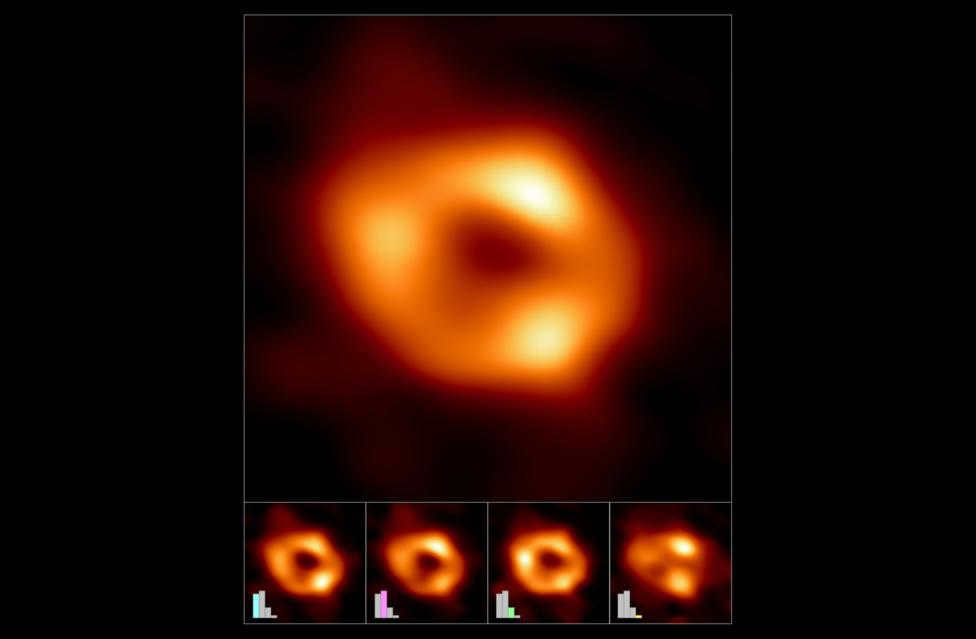
The confirmation of the structure of the spiral galaxy Milky Way was officially announced on May 12, 2022. The Event Horizon Telescope (EHT) project scientists unveiled images of Sagittarius A*, a supermassive black hole situated at the central position of our galaxy, during a conference held on that day.
The Origin of Black Holes
In 1915, the Einstein-Hilbert equations, which describe gravitational fields, were derived from Albert Einstein’s proposed General Theory of Relativity. That same year, Karl Schwarzschild obtained one of the exact solutions to these equations. It was concluded that in cosmic space, there must exist regions of space-time with such strong gravitational attraction that even objects moving at the speed of light (including photons) cannot escape. These astrophysical objects were initially referred to as “collapsed stars” or “frozen stars”. However, in 1967, American theoretical physicist John Archibald Wheeler popularized the term “black hole” in his lecture “Our Universe: known and unknown”. The exact origin of this captivating and intriguing term is unknown, but since then, black holes have captivated the minds of many.
For a considerable period of time, these regions of immense gravitational pull were purely theoretical entities, deduced solely through mathematical calculations and in accordance with the principles of general relativity. It is impossible to physically interact with a black hole or even visually perceive it – photons of light are unable to escape its grasp, rendering the object itself invisible to any observer. The only evidence of its existence lies in the manner in which these entities exert their influence on the neighboring stars.
Event Horizon Telescope
While the black hole itself remains invisible, there exists a potential to observe the luminous gas surrounding it: the glowing matter in the accretion disk that orbits and gradually falls into the black hole. To accomplish this, the Event Horizon Telescope project was established. It consists of a network of eight radio telescopes-interferometers that collect and combine data from multiple interferometry stations across the Earth, creating a very long baseline (VLBI). Essentially, these telescopes, scattered in various locations on our planet, function as a colossal virtual radio telescope with an antenna diameter comparable to that of Earth.
What is interferometry?
Interferometry is a technique that utilizes the phenomenon of interference to split a beam of electromagnetic radiation or radio waves into multiple coherent beams. These beams follow separate paths to the grating of a radio telescope, where they combine to create a single interference pattern for observation. This innovative method enables the construction of multiple smaller telescopes instead of relying on a single large telescope. By placing these smaller telescopes at varying distances from each other, a high angular resolution telescope is achieved.
During observation, the telescope captures the leading edge of an electromagnetic wave emitted by a source at different time intervals. The data is then synchronized using a specialized atomic clock. This synchronization allows for an increase in the angular resolution of telescopes to tens of angular microseconds when observing a single object from different locations on Earth.
When measuring plane angles in degrees in astronomy, a unit called the angular second is used. This unit is approximately equal to the angle at which a soccer ball can be seen from a distance of about 45 km. The EHT telescope deals with measurements that are a hundred-thousandth of an angular second. To put it in perspective, a black hole that is thousands of light years away has roughly the same angular size as an orange when viewed from the distance between the Earth and the Moon. This is why multiple interferometers are necessary to observe it.
However, there is a disadvantage to this system. Synchronized observational data from all telescopes must be brought together using long and resource-intensive computer calculations. This means that observations can last for days, followed by months or even years of data processing.
From Messier 87 to Sagittarius A*.
On April 10, 2019, the world witnessed the release of the first-ever image capturing the shadow of a black hole. This groundbreaking achievement showcased a supermassive black hole located in Messier 87, an enormous elliptical galaxy that holds the title for being the largest in the Virgo constellation. Despite its astonishing distance from Earth, approximately 53.5 million light-years away, Messier 87 remains incredibly observable. In fact, it stands as one of the most colossal entities ever discovered, with a mass of around 3.5 billion solar masses. Currently, only two supermassive black holes surpass its immense size.
The image captured by scientists may not be visually stunning – a dull orange donut, as if taken with a low-quality camera phone. However, it is important to understand that this very “donut” is a luminous gas disk, swirling around the black hole at a velocity of approximately 1,000 km/s and stretching to half a light year in size (to put it in perspective, the Voyager spacecraft, which has been traveling away from Earth for decades, has covered less than a thousandth of this distance). The amount of gas being consumed by the black hole amounts to about one solar mass every ten years.
The ability to observe this phenomenon using a massive virtual interferometer is one of the most significant advancements in astrophysics in recent decades. Naturally, following the initial experiment, scientists immediately turned their attention to the most significant black hole for Earth, which happens to reside at the center of our Milky Way galaxy.
Astronomers have long proposed the existence of a supermassive celestial body at the center of spiral galaxies like the Milky Way, which acts as the central mass around which the galaxy rotates. In the previous century, it was hypothesized that this body could be a supermassive black hole, an idea supported by Einstein’s equations. However, it was necessary to provide evidence to support this hypothesis.
The black hole at the center of our galaxy is much smaller than the one found in Messier 87, with a mass about a thousand times lighter at approximately 4 million solar masses. However, its proximity is much closer, located 27 thousand light years away. Astronomers have faced difficulties in observing this black hole due to numerous interfering objects along the way. Nevertheless, on May 12th of this year, an image was released confirming the theoretical predictions.

A team of scientists has successfully charted the precise location of the central region of our Milky Way galaxy. Utilizing X-ray technology, they conducted an in-depth examination of the deep space regions that are typically inaccessible to even the most advanced optical telescopes. Their findings revealed compelling evidence of powerful cosmic cataclysms, potentially uncovering previously undiscovered phenomena.
X-ray vision
The heart of the galaxy has proven to be a truly extraordinary location. Situated approximately 26,000 light-years away from Earth, resides a colossal black hole boasting a mass equivalent to 4 million suns. The immense gravitational pull exerted by this celestial behemoth causes the surrounding matter to plummet towards it with tremendous force. As these streams of gas collide and rub against each other, they become intensely heated. Consequently, the once pitch-black black hole is transformed into a luminous spectacle, with its surrounding cloud of incandescent plasma shining as brilliantly as a hundred suns.
The energy contained within this seething maelstrom is so vast that it propels jets of matter into the surrounding space, defying the gravitational clutches of its supermassive “mistress”. These eruptions give rise to spectacular outbursts and other tumultuous phenomena.
The activity of the black hole leaves its mark on the entire core of the Galaxy. Intense radiation emitted during its flares hinders the formation of stars and likely destroys nearby planets on a regular basis. Magnetic fields penetrate the hot interstellar gas, causing it to move in a synchronized manner. Meanwhile, in the neighboring dense and frigid hydrogen clouds, matter churns and moves chaotically at speeds of tens of kilometers per second.
Overall, the center of the Milky Way presents astronomers with a unique opportunity to study phenomena that are unlike anything else in the Galaxy. Unfortunately, this task is not simple: the central region of our stellar island is concealed by dense clouds of dust and gas. These clouds are impenetrable even to the most advanced optical telescopes.
By capturing a vast network of hot gas filaments, the instrument has managed to observe a remarkable phenomenon. These elongated structures span tens of light-years in length, yet their diameter is hundreds of times smaller. The origin of this cosmic fabric remains uncertain, but scientists have recently put forward a captivating hypothesis.
Electrical malfunction caused by magnetic reconnection
By comparing data from Chandra’s X-ray map and the MeerKAT radio telescope, astronomer Wang discovered a remarkable phenomenon. Both images showed a filament known as G0.17-0.41, which extends 20 light-years and runs almost perpendicular to the Galactic plane.
After analyzing the data collected by these instruments, Wang reached an intriguing conclusion. He determined that G0.17-0.41 is the result of magnetic reconnection, a process in which opposing magnetic field lines converge and partially annihilate each other. This process releases stored energy, causing the surrounding matter to heat up. It can be likened to an explosion or an electrical malfunction.
Magnetic reconnection is a familiar occurrence to experts in the field of solar studies: it is the driving force behind solar flares, the expulsion of matter into outer space, and other peculiarities of our beloved sun. However, for the very first time, this phenomenon, which is typically associated with stellar surfaces, has been detected in the vicinity of a black hole and, more broadly, in interstellar space.
The magnetic field surrounding G0.17-0.41 is relatively weak. Wang’s calculations estimate it to be around 1 mGs, which is a million times less powerful than the magnetic field found on the surface of a typical household arc-shaped magnet. Despite its weakness, the field’s immense length, spanning tens of light-years, allows it to accumulate energy on a grand scale. This energy is released during reconnection events, causing the surrounding matter to be heated to temperatures in the tens of millions of degrees, surpassing the temperature at the core of the Sun. It is therefore not surprising that the X-ray emissions produced by this long and hot filament are visible even from the orbit of Earth.
Thus, the latest “Chandra” map has captured plumes of hot gas in unprecedented detail, stretching 700 light years above and below the Galactic plane. Scientists are still debating the source of heat for the gas streams emanating from the center of the Milky Way. It could potentially be a combination of magnetic reconnections and supernova explosions.
Moreover, this phenomenon could act as a natural accelerator for cosmic rays – high-energy particles originating from the depths of the Galaxy. At significant distances from the black hole, it is capable of stirring up interstellar gas, leading to the formation of stars. It appears that astronomers have uncovered one of the crucial mechanisms responsible for regulating the life cycle of our Galaxy.
The author’s views may differ from the editorial opinion.
10 Photos of Human Presence in Space: Moon Trees, Astronauts’ Offspring, and Radishes at SpaceX
Explore these 10 captivating images showcasing the various ways humans have ventured into space, from the fascinating Moon trees to the courageous astronauts’ children and even the growth of radishes on SpaceX missions.
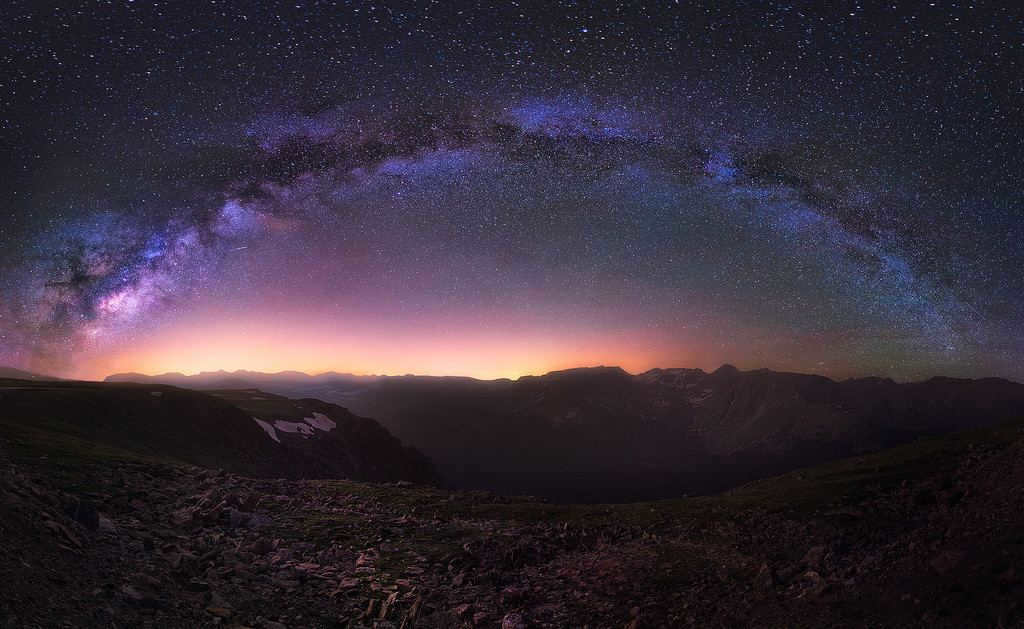
Away from the bustling city lights, on dark nights when the moon is absent, the sky reveals its full glory with every star visible. One cannot help but admire the stunning beauty of the starry sky, where a strip of white known as the Milky Way stretches across the vast expanse. This celestial phenomenon passes through various constellations in the southern hemisphere, such as Sagittarius, Scorpius, and Shield, creating a mesmerizing display of brightly glowing star clusters. The Milky Way shines with exceptional brilliance in this part of the sky, with the center of the Galaxy itself positioned in the same direction.
“The center of the Milky Way”
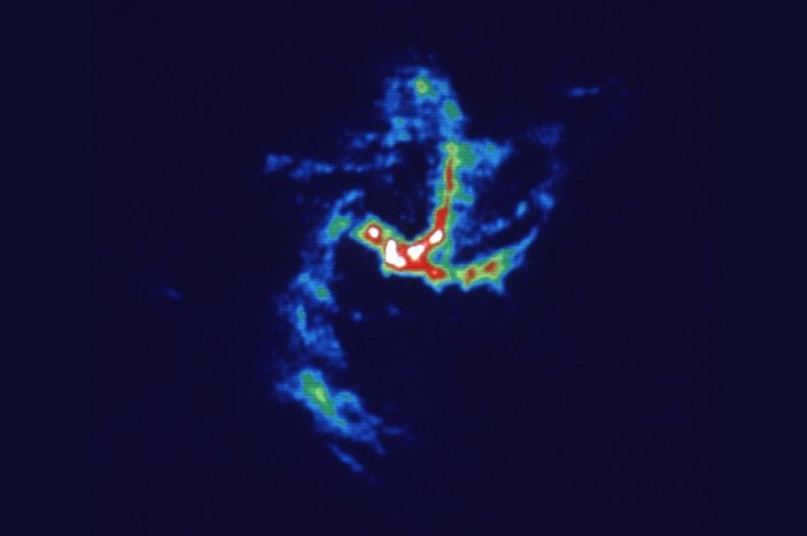
Gas clouds surrounding a black hole
For a long time, the center of our Galaxy was believed to be planet Earth. Then, scientists made another incorrect assumption that the center of the Milky Way Galaxy is the Sun. However, the reality is that the “heart” of the Galaxy is actually a supermassive black hole that devours everything in its path and is nearly three million times larger than the Sun.
The orbits of stars around the center of the Milky Way provide further confirmation of this.
This confirmation was recently obtained by scientists through regular, 15-year-long monitoring of the galactic center using telescopes from the ESO located at the La Silla and Paranal observatories.
The Hidden Celebrity
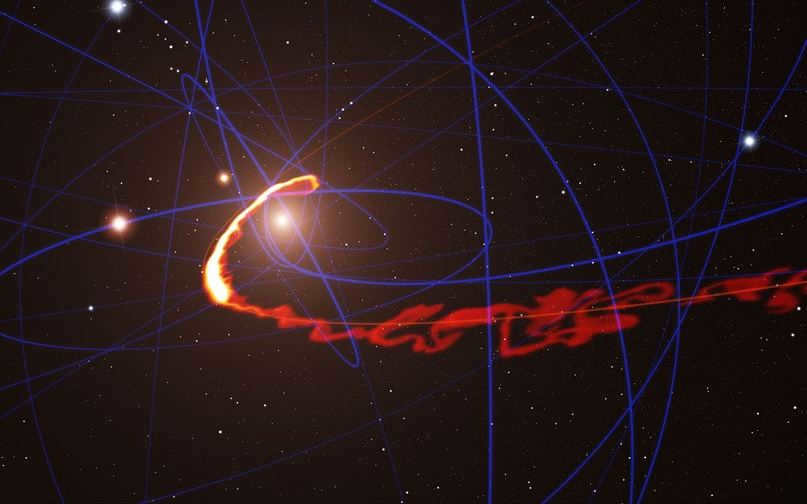
Modelling a gas cloud that has been disrupted by the presence of a black hole
A black hole is a type of massive celestial object that is not visible even with the most advanced astronomical instruments. This is because the unique physical properties of black holes prevent any radiation from escaping their surface due to their extremely powerful gravitational pull. The detection and study of these “invisible stars” can only be achieved by examining the characteristic phenomena that occur in their vicinity. Therefore, our current understanding of black holes and their actual existence is still limited.
A hidden predator
Simulating the descent of gas into a black hole
All black holes during their “lifetime” have the ability to exist in one of two conditions. The first is the dormant condition, which is currently exhibited by the black hole at the core of the Milky Way, and the second is the active condition. We can describe the black hole as pulsating, alternately consuming approaching matter (regardless of whether it is a planet or an asteroid) and then remaining dormant, waiting for its next victim.
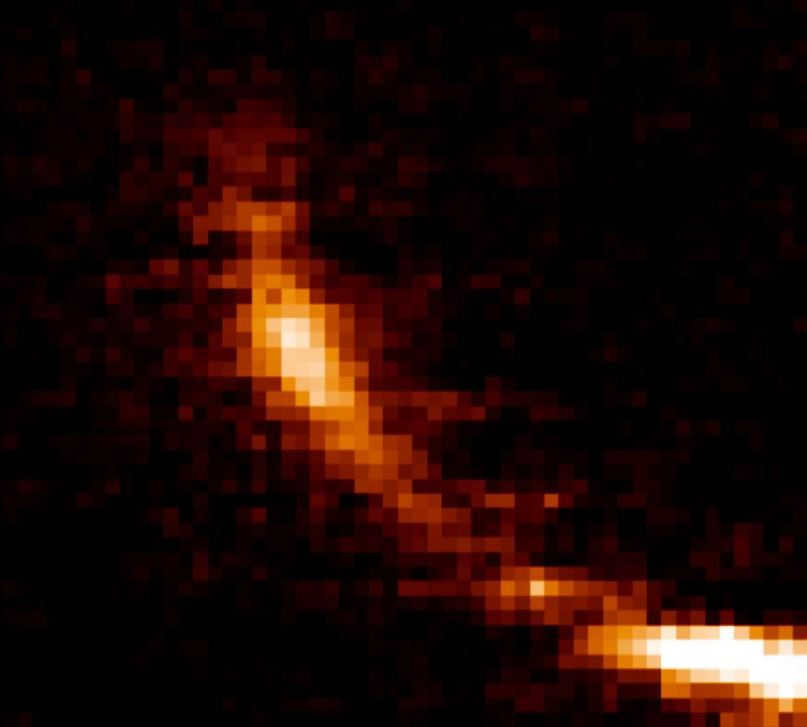

A gas cloud is being torn apart by a black hole located at the center of the Milky Way.
The substances that get caught in the gravitational pull of the black hole spiral and gradually get absorbed by it. However, this absorption process does not happen all at once. The “victims” disappear into the dark abyss and then reappear, experiencing peculiar jerks on the surface of the black hole. This can be likened to pouring water down a sink. As the water swirls and approaches the drain, some of its energy gets transferred into sound waves. Similarly, when objects are absorbed by a black hole, energy is generated.
